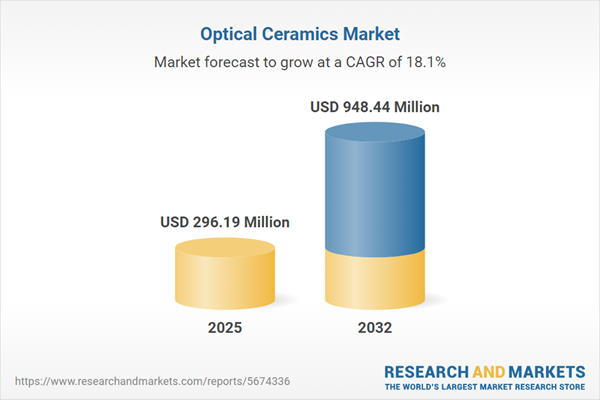Speak directly to the analyst to clarify any post sales queries you may have.
The optical ceramics market is emerging as a strategic priority for organizations seeking transparency, durability, and adaptable materials in mission-critical operations. Increasingly, senior leaders are exploring optical ceramics to enhance product reliability and drive innovation within their fields.
Market Snapshot: Key Trends and Growth Drivers in the Optical Ceramics Market
In recent years, the optical ceramics market has entered a period of sustainable growth, shaped by consistent innovation in material science and engineering. Enhanced transparency, thermal stability, and extended service life have positioned optical ceramics as favored solutions for sectors where reliability and safety are non-negotiable. Adoption is expanding rapidly in automotive, high-performance optics, medical diagnostics, and defense applications, as organizations focus on meeting customer demands and evolving regulatory standards. Process improvements and rigorous quality controls have further enabled seamless integration of these materials, supporting a wider array of performance-driven uses. New benchmarks and standards are influencing market acceptance, as companies prioritize solutions that reinforce resilience.
Scope & Segmentation of the Optical Ceramics Market
This analysis delivers actionable intelligence to senior decision-makers by spotlighting high-impact trends, potential investment opportunities, and core drivers shaping the optical ceramics sector. The report covers the following critical segments:
- Product Types: Alumina, silicon carbide, silicon nitride, and zirconia each offer distinct advantages, such as robust wear resistance and strong mechanical properties for specialized engineering uses.
- Forms: Transparent ceramics, advanced ceramic powders, and specialized coatings support demanding photonic applications and extended operational durations.
- Coating Types: Abrasion-resistant, anti-reflective, and thermal barrier coatings enhance life span and help maintain the performance of optical ceramics across diverse operating conditions.
- End Use Industries: Automotive, electronics, energy, manufacturing, medical device, defense, and aerospace sectors all benefit from the material’s ability to meet precise, high-reliability standards for innovation and operational integrity.
- Regional Coverage: Comprehensive analysis includes the Americas, Europe, Middle East & Africa, and Asia-Pacific, with regional trends influencing adoption priorities and compliance strategies.
- Companies Analyzed: Reviewed organizations include CeraNova Corporation, CoorsTek Inc., OptiPro Systems, CeramTec GmbH, Morgan Advanced Materials plc, Denka Company Limited, Saint-Gobain S.A., SCHOTT AG, Surmet Corp., and Murata Manufacturing Co., Ltd., focusing on competitive approaches and advancements.
Key Takeaways for Senior Decision-Makers
- Innovative manufacturing processes, especially additive manufacturing and hot isostatic pressing, enable development of ceramics tailored to stringent application requirements.
- Optimized dopant management and advanced grain boundary engineering elevate performance dependability, supporting greater use in health and safety-critical environments.
- Digital tools in procurement supply enhanced visibility and flexibility, making it easier to address material supply risks and quickly adapt to change.
- Cross-disciplinary collaboration between materials scientists and photonics engineers accelerates time-to-market for new solutions, helping organizations maintain adaptability.
- Growing attention to sustainability and recycling in sourcing decisions is influencing supplier choice and boosting compliance with emerging regulations and investor expectations.
- Investment in scalable manufacturing and robust intellectual property strategies provide defense against shifting competitive dynamics.
Tariff Impact and Supply Chain Responses
Recent U.S. tariff regulations have led to higher procurement costs and new challenges in the sourcing of optical ceramics and key raw materials. In response, organizations are revising supply chain frameworks, increasing automation, and evaluating vertical integration. These moves are intended to maintain reliable supply, protect operational continuity, and mitigate exposure to economic unpredictability.
Methodology & Data Sources
Findings are derived from comprehensive secondary research, thorough technical literature reviews, proprietary data models, and direct engagement with industry specialists. Scenario modeling and benchmarking validate the analysis, supporting strategic planning in risk-sensitive market scenarios.
Why This Report Matters
- Enables top executives to identify and interpret pivotal technology shifts and disruptive trends specific to the optical ceramics market.
- Provides procurement and supply chain leaders with focused insights for sustaining compliance and resilience amid changing regulatory demands.
- Delivers benchmarking and competitive analysis to aid in aligning resources with dynamic operational and technology environments.
Conclusion
This report offers senior leaders actionable insight to guide strategic decisions, build resilience, and manage evolving risks in the optical ceramics market.
Additional Product Information:
- Purchase of this report includes 1 year online access with quarterly updates.
- This report can be updated on request. Please contact our Customer Experience team using the Ask a Question widget on our website.
Table of Contents
3. Executive Summary
4. Market Overview
7. Cumulative Impact of Artificial Intelligence 2025
Companies Mentioned
The companies profiled in this Optical Ceramics market report include:- CeraNova Corporation
- CoorsTek, Inc.
- OptiPro Systems
- CeramTec GmbH
- Morgan Advanced Materials PLC
- Denka Company Limited
- Saint-Gobain S.A.
- SCHOTT AG
- Surmet Corp.
- Murata Manufacturing Co., Ltd.
Table Information
| Report Attribute | Details |
|---|---|
| No. of Pages | 191 |
| Published | November 2025 |
| Forecast Period | 2025 - 2032 |
| Estimated Market Value ( USD | $ 296.19 Million |
| Forecasted Market Value ( USD | $ 948.44 Million |
| Compound Annual Growth Rate | 18.1% |
| Regions Covered | Global |
| No. of Companies Mentioned | 11 |









